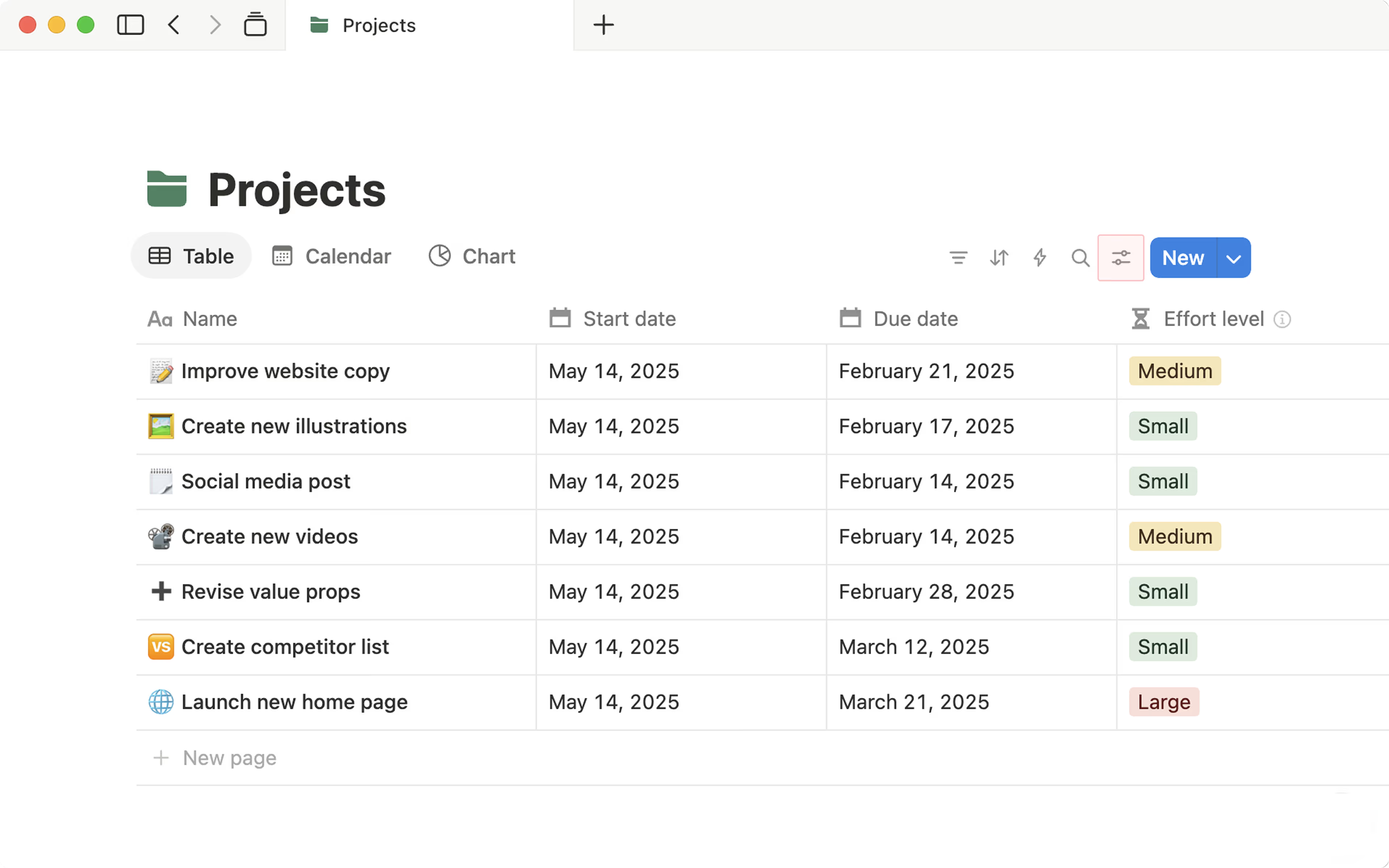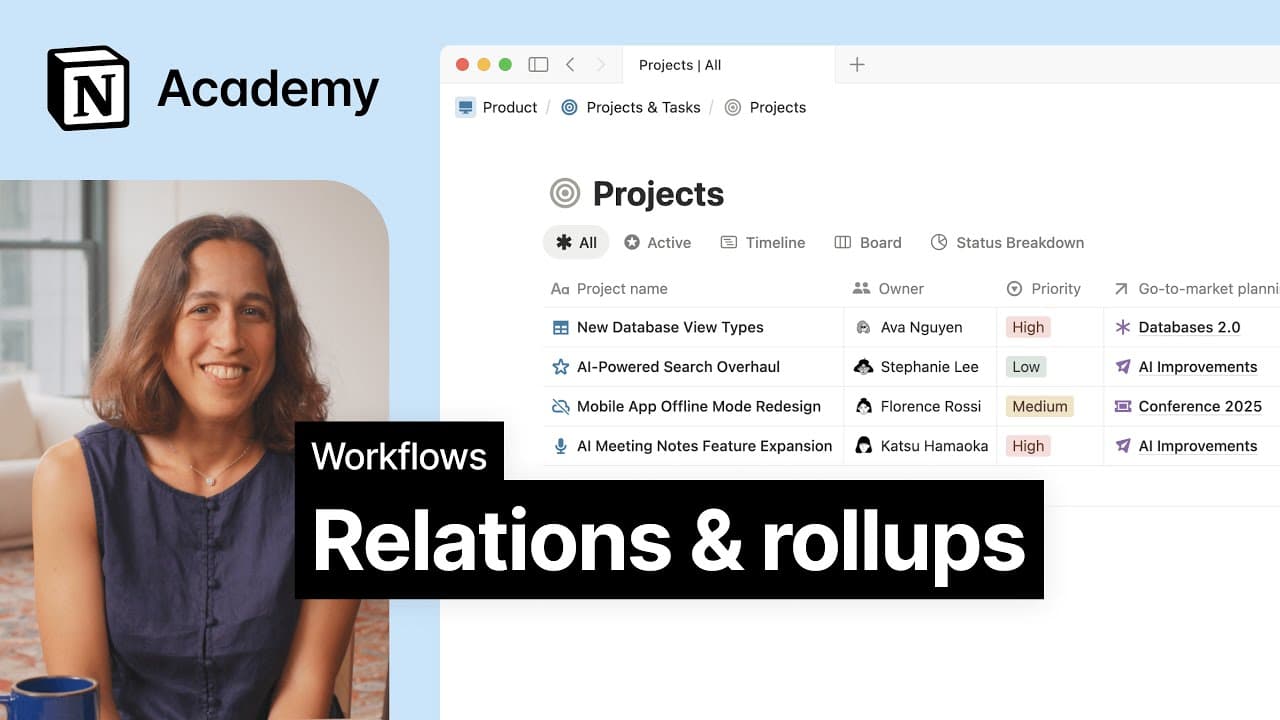Database properties

Database properties add all kinds of context to your database items, like due dates, task owners, relevant URLs, last edited timestamps, and more. Use these properties to filter, sort, and search your data 🧩
Property | Description |
Text | Add text that can be formatted. Great for summaries, notes, and descriptions! |
Number | Accepts numbers. These can also be formatted as currency or progress bars. Useful for tracking counts, prices, or completion. |
Select | Choose one option from a list of tags. Useful for categorization. |
Status | Track this item’s progress using status tags categorized by To-do, In Progress, or Complete. |
Multi-Select | Choose one or more options from a list of tags. Useful for tagging items across multiple categories. |
Date | Accepts a date or a date range (time optional). Useful for deadlines, especially with calendar and timeline views. |
Formula | Perform calculations based on other properties using Notion’s formula language. Learn more here → |
Relation | Connect databases and mention database pages. Useful for connecting items across your workspace. Learn more here → |
Rollup | View and aggregate information about properties from relation properties. Useful for summarizing interconnected data. Learn more here → |
Person | Tag a person or group from your Notion workspace. Useful for assigning tasks or referencing relevant team members. |
File | Upload files and images for easy retrieval. Useful for storing documents and photos. |
Checkbox | Use a checkbox to indicate whether a condition is true or false. Useful for lightweight task tracking. |
URL | Accepts a link to a website and opens the link in a new tab when clicked. |
Accepts an email address and launches your mail client when clicked. | |
Phone | Accepts a phone number and prompts your device to call it when clicked. |
Created time | Records the timestamp of an item's creation. Auto-generated and not editable. |
Created by | Automatically records the person who created the item. Auto-generated and not editable. |
Last edited time | Records the timestamp of an item's last edit. Auto-updated and not editable. |
Last edited by | Records the person who edited the item last. Auto-updated and not editable. |
Button | Automate specific actions with one click. Learn more here → |
ID | Automatically creates a numerical ID for each item. IDs are unique and cannot be manually changed. |
Place | Accepts a location via location services, a location name, or an address. Learn more here → |

Notion AI can save you time by autofilling certain types of database properties! Learn more here →
You can apply a layout to all pages in a database so that all of your database properties can be organized how you want. Learn more here →
To create your first property in a database, click Add property. Give your property a name, then choose a property type.
To add a property to a database that already has existing properties:
Select
+next to the right-most property. Give your property a name, then choose a property type.In table view, click on an existing property →
Insert leftorInsert rightdepending on where you want your new property to live in your table. Give your property a name, then choose a property type.
To manage and edit the properties of a database, open the settings menu at the top of the database and select Edit properties.

From here, you can:
Search for a property.
Create a
New property.Click into specific properties to edit them. You can adjust settings that are specific to a property (for example, you can wrap a text property), duplicate a property, or delete a property.
You can also edit individual properties by clicking directly into them in your database. This will open a menu where you can edit the property’s name, filter or sort by that property, run calculations, and more.
Hide or show properties
If you want specific properties to be hidden or shown in a database view:
Open the settings menu at the top of the database.
Select
Property visibility.Select
👁️next to a property to hide or show it.
Any data put into a property is called a value. The way you edit values is different for each type of property. Here are just a few examples:
For
SelectandMulti-selectproperties, you'll be prompted to add tags by typing what you want and pressing enter after each. Colors are randomly assigned.You can add as many unique tags to these menus as you want.
Edit tag names and colors, or delete them by clicking on the property field (i.e. the table cell), then
•••that appears to the right when you hover over any property.Reorder tags by grabbing the
⋮⋮icon to their left and dragging.
For
Dateproperties, clicking to add data will bring up our date picker, where you can select the day relevant to the database item — maybe it's an event date or deadline.Click
Remindto set a reminder in this property that will notify you on the given date and time.Switch on
End dateto define a range of dates in this property.Switch on
Include timeto choose an exact time, not just a day.Click
Date format & timezoneto modify these settings.Click
Clearto remove any value in the date property.
For
Files & mediaproperties, clicking on the field provided will prompt you to upload a file, or paste a link to embed a file.You can also drag a file from your computer into the property to upload it.
You can add multiple files into any field at once.
Click on the
•••to the right of uploaded files toDelete,Download,Full screenorView original.Use the
⋮⋮to the left of uploaded files to drag and re-order them.
In a
Personproperty, you can tag other members or guests in your workspace.Just type their names and press
enterafter each.To delete anyone tagged, click on them, then click
Xnext to their name.
Values automatically appear for these properties:
Created time,Created by,Last edited time,Last edited By.You can simply type or paste values for
URL,Email,PhoneandNumberproperties, just like you would for aTextproperty.Editing values for
RelationandRollupproperties requires multiple steps.

Note: To apply conditional color to database pages, you must have Can edit content access, Can edit access, or Full access to that database. If you can only view or comment on a database, you can see color for database pages but can’t edit any color settings.
To help you visually distinguish your database items from one another, you can assign a color to database pages based on certain conditions. For example, maybe you want all overdue tasks in a task database to be shown in red.
To apply conditional color to a database view:
Select the slider icon at the top of your database view.
Under
View settings, selectConditional color.Select
New color setting.Select the database property you want to color by.
Open the dropdown next to your property name and set a rule for your color setting.
Select a
Page backgroundcolor.If applicable, your database pages will match the color of the property values associated with them by default. For example, if your priority property has
P0in red andP1in orange and you’re coloring your database by priority, all P0 pages will be displayed in red and all P1 pages will be displayed in orange. You can change this at any time!
If you're in table view, open the menu next to
Apply toand choose whether you’d like to apply the color to the entire row or just the property that your rule applies to.Select
Add anotherto create additional color conditions for your database view.
How conditional color can be applied
Conditional color is available on the following views:
Table
Calendar
Timeline
List
Board
Feed
Conditional color can be applied based on the following properties:
Select
Multi-select
Status
Title
Text
Number
Date
Person
Checkbox
Formulas
Relations
Rollups
Conditional color settings are created at the view level. Different database views can have different conditional color settings, and conditional color settings applied to one database view won’t automatically apply to the database’s other views. However, when you duplicate a view, its color settings will also be duplicated.
Conditional color applies at the page level; at this time, you can’t have specific properties colored in a page or card. Color applies to a page’s entire background.
To apply conditional color to a property and not an entire database page, you must be in a table view of a database.
Delete a color setting
To delete a color setting:
Select the slider icon at the top of your database view.
Under
View settings, selectConditional color.Select
🗑️next to the setting you want to delete.
You can leave comments in database properties, only when you’re in table view or when you have a database page open.

Note:
At this time, you can’t comment in name, formula, rollup, button, and unique ID properties.
Properties must already have a value assigned before someone can comment on them.
To comment on a property while in table view:
Hover over a property for a database item.
Select the
💬that appears.Enter your comment.

Note: While you can comment on a checkbox property, you’ll have to open the database page to do so — there won’t be a way to do this from table view.
To comment on a property while in a database page:
Hover over a property.
Select the
💬that appears, or select the⋮⋮to the left of the property →Comment.Enter your comment.
Once a comment has been made, you’ll see 💬 next to the property it’s attached to. You can select 💬 to see the comment and add to the conversation.
You can assign specific access levels to people mentioned in a person or created by property in a database page. Learn more about this here →
